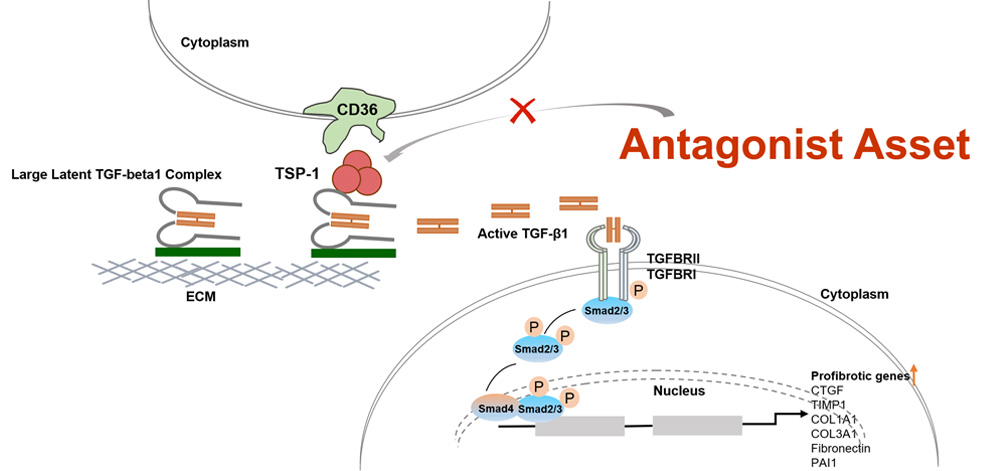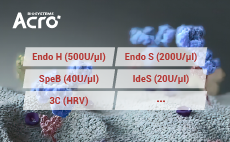1. Asset type:Antagonizing TSP1/CD36 Polypeptide.
2. Dosage form: Injection or Nebulization.
3. Mechanism of action:TGF-β1 is a central player in fibrosis and cancer diseases. TSP1, a multi-functional matricellular ECM, is upregulated expression in tissue injury and repair. TSP1 binds to CD36, and then binding to latent TGF-β complex converts latent TGF-β to its biologically active form through a non-proteolytic mechanism. TSP1 binding to CD36 was required for TGF-β activation. HTPEP-001 peptide competitively binds to TSP1 to block the binding of TSP1 and CD36,leading to inhibit TGF-β1 activation.

4. Indication:Progressive Fibrosis Interstitial Lung Disease (PF-ILD), Solid Tumor. Note:PF-ILD: Including idiopathic pulmonary fibrosis (IPF), connective tissue disease-related interstitial lung disease (CTD-ILD), pneumoconiosis, Sarcoidosis, viral infectious interstitial lung disease with progression of pulmonary fibrosis.
5. Research phase: IND Approval in China.
6. Research progress:
1) The pre-clinical pharmacodynamics study has been completed. Compared with nintedanib in rats induced fibrosis by bleomycin, HTPEP-001 displays obvious better therapeutic effect for IPF than Nintedanib.
2) The pre-clinical study in rats, beagles and cynomolgus monkey have been completed. They show no obvious adverse effects, and HTPEP-001 possessing the margin of safety about 100 folds that is significantly better than nintedanib.
3) Manufacturing of the HTPEP-001 is a stable and highly qualified process, formulations of both inhalation and infusion solutions are well characterized and controlled.

Explore our catalog of therapeutic antibody solutions to find the right products for you! We are dedicated to delivering solutions designed to help you drive innovation and push the boundaries of what therapeutic antibodies can be.

Organoid Toolbox is a collection of organoid solutions including ready-to-use organoids, organoid differentiation kits, and a variety of services to accelerate the progress of your drug development project.

To enable antibody characterization methodsACROBiosystems has developed a series of enzymes.such as ldeS, SpeB, EndoH, and Endo S proteases, toassist with the characterization of antibodies and theirrelated post-translational modifications (PTMs)

ACROBiosystems developed a series of GMP grade cytokines under the GMP grade quality management system. Those products are all suitable for T/NK cell generation, activation, and proliferation in cell therapy research.

50+ targets designed for CAR detection, including PE/FITC/biotin labeled proteins. The key reagents for CD19 and BCMA were FDA DMF filed which can support your IND, NDA and BLA process.

GMP grade cytokines, reagents for cell activation, gene edition, DNA/RNA removal, etc. Particularly focus on product design, quality control and solution-based support to link each phase of your cell and gene therapy journey.

Full length multi-pass TPs with stabilized structure and high bioactivity for immunization, antibody screening, cell based assay and CAR detection, including hot CD20, Claudin 18.2, CD133, GPRC5D,CCR8, CCR5, etc.

A series of immune checkpoints including classic co-inhibitory and co-stimulatory receptors. The comprehensive catalog contains 100+ targets with various species and tags, and the high-quality proteins are in good batch-to-batch consistency.

To meet the needs of ADCs development, ACROBiosystems can provide: A variety of high-quality target proteins; MMPs/Cathepsin/uPA for cleavable linker; Anti-payload antibodies & anti-idiotypic antibodies for immunogenicity and PK analysis; SPR/BLI analytical and ADA development service.

Comprehensive collection of Fc receptor proteins, including their common variants, which can help expedite your antibody development.

Comprehensive cytokine targets including interleukins, growth factors, chemokines, TNFs, etc. are expressed by HEK293 to ensure their natural structure. Their high purity is verified by SDS-PAGE/HPLC/SEC-MALS and high bioactivity is verified by ELISA/SPR/BLI.

Aneuro provides innovative solutions for neuroscience research. Recombinant proteins, neural factors, pre-formed fibrils, electrophysiological electrodes, as well as Organoid Toolbox all in Aneuro aiming to advance neuroscience research, develop therapeutic interventions, and improve diagnostic methods for neurological diseases.
This web search service is supported by Google Inc.
